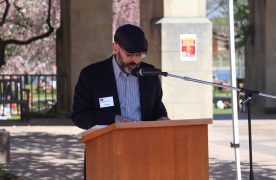The beauty of New Orleans jazz is that it does not originate from a blank slate. Instead, the genre feeds off a deep-seeded African-American resilience after the era of slavery. In the 19th and early 20th centuries when Spanish and French colonialism was a thing of the past, traces of this culture were left behind like settled ashes. But New Orleans has always been a melting pot aflame with culture — a port city providing a meeting place for people all around the world.
European instruments like the saxophone, trumpet and the piano combined with the rhythm, feel and quality of a bluesy sound derived from traditional African music. The rebirth of this sound rapidly spread.
This is not the type of jazz you might hear at your grandparents’ favorite restaurant. It isn’t passive background music. While modern jazz has a connotation of being boring, and belonging to the upper class — authentic New Orleans jazz is anything but. New Orleans jazz is in your face. It is loud and it is boisterous.
I am lucky enough to call New Orleans a second home. With half of my family currently residing in and around the vivacious crescent city, I have a great excuse to visit often. Thanksgiving was the perfect opportunity to eat my way through the city — along the way, filling my ears with music I couldn’t hear anywhere else in the world.
Walking through the French Quarter, dodging tipsy tourists, I was on a mission: I heard brass and I had to find it. Of course, it didn’t take much searching. On practically every other corner, there’s a live performance of sorts. Countless full-sized brass bands post up with a five-gallon bucket performing for every pair of ears within a five-block radius. And boy, is it loud. With three pitched trumpets, two whining trombones, a full set of drums complete with a cowbell, the deep voice of a blues singer and, of course, a booming tuba, there’s no escaping the Cajun culture. Picture it — people of all ages and ethnicities are dancing in the street, even your grandfather has his cane in the air. You can’t help but move your feet. This music is infectious, chaotic, fully-encompassing and all-engaging. You simply can’t walk away until the set is over.
I would argue that New Orleans is both literally and figuratively the most colorful city in the United States. Of all destination cities in the country, New Orleans one of the only ones with an African-American majority — 60 percent to be exact. A minority that is consistently marginalized across the country actually creates the majority in this cultural mecca. Amidst the countless tourists from across the globe, black culture takes center stage, claiming the resilient and consistently phenomenal jazz scene.
Historically, much of the South and the rest of the country have tried to stamp out African-American culture. For so long, this country has been led by white male leaders, all catering toward a single homogenous group. Meanwhile, for over a century, leaders in New Orleans have kept jazz at the forefront of the city’s culture, ensuring that it can continue to mature alongside the historic city. While some aspects of the genre have evolved over time, most acclaimed brass bands stick to the fundamentals of jazz. This past week, I was lucky enough to see the one and only Rebirth Brass Band, a “hard as hell” Grammy Award-winning group. Founded in 1983, Rebirth stays true to the heart of New Orleans jazz. You won’t find a synthesizer or a pre-recorded sound anywhere in its vicinity.
Would New Orleans really be New Orleans without the jazz? Of course not! The jazz (and let’s not forget about the food) are what makes New Orleans authentic.











